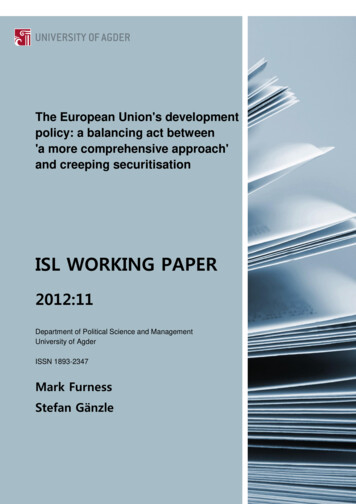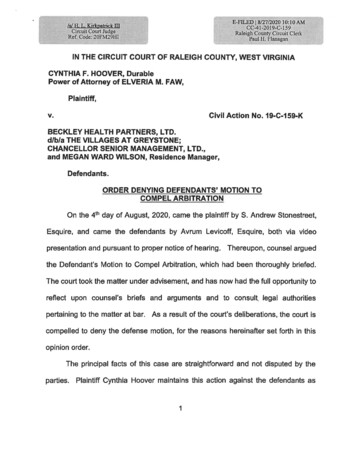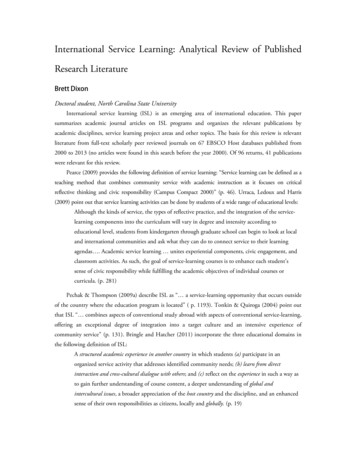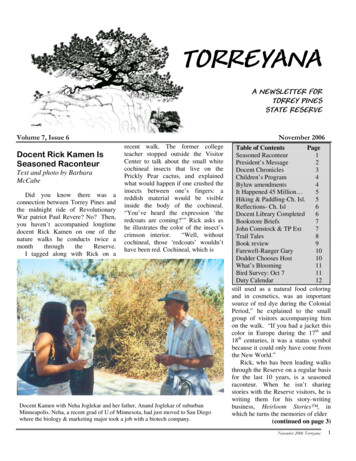
Transcription
The European Union's developmentpolicy: a balancing act between'a more comprehensive approach'and creeping securitisationISL WORKING PAPER2012:11Department of Political Science and ManagementUniversity of AgderISSN 1893-2347Mark FurnessStefan Gänzle
Abstract‘Security’ has become prominent in official EU development discourse in recent years,and references to security concerns are routinely included in policy statements anddocuments. Our objective in this paper is to determine whether security concerns havehad a growing influence over EU development policy and aid allocation. If so, we areinterested in whether this trend can properly be understood as ‘securitisation’ in thecritical sense that resources are being diverted away from socio-economic development,or whether we should see it as a positive trend towards greater coherence in EUdevelopment policy.This paper is being prepared as a draft chapter for a book on the securitisation of foreignaid edited by Stephen Brown and Jörn Grävingholt. It is a draft, so please contact theauthors if you wish to quote from it or cite it.Mark Furness is a senior researcher in the Bi-and Multilateral Development PolicyDepartment at the German Development Institute in Bonn, Germany.Email: mark.furness@die-gdi.de.Stefan Gänzle is associate professor at the Department of Political Science andManagement, University of Agder, Kristiansand, Norway.Email: stefan.ganzle@uia.no.1
“The challenge now is to bring together the different instruments andcapabilities: European assistance programmes and the EuropeanDevelopment Fund, military and civilian capabilities from Member States andother instruments. All of these can have an impact on our security and on thatof third countries. Security is the first condition for development.Diplomatic efforts, development, trade and environmental policies shouldfollow the same agenda.”European Security Strategy 2003:131. IntroductionA decade after the release of the European Security Strategy (ESS), its affirmation thatdevelopment and security policy should work more closely together for the bettermentof people in developing countries is still one of its most discussed features. The ESS’vision of a more comprehensive approach to security and development raises severalquestions regarding the potential ‘securitisation’ of EU development policy and foreignaid. Is the EU’s approach overly idealistic and uncritical regarding the potential pitfallsof trying to combine security and development policy? Do key concepts that havebecome prominent since the strategy was launched, such as fragile states and the‘whole-of-government’ approach, reflect how European policymakers perceive the newreality of international development? Are decisions about the allocation and objectivesof the European Commission’s aid budget unduly driven by security concerns? Has theCommission itself used securitisation as a means for increasing its aid budget and itspolicymaking responsibilities? This paper addresses these questions by discussing howEU policies and aid practices at the interface of security and development have evolvedsince the turn of the 21st century.The securitisation of EU policies has been explored in greater depth in the context ofjustice and home affairs in general and migration, asylum, border control, dataprotection in particular (see e.g. Neal, 2009; Huysmans, 1998, 2006; Hayes and Bunyan,2003; Loader, 2002). The concern that EU development policy might also be increasingly‘securitised’ became more widely expressed as the EU began to articulate a commonforeign and security policy (CFSP) and deployed military missions to Africa from 2003as part of its evolving Common Security and Defence Policy (CSDP) (Orbie, 2008:4).Some observers have noted parallels between these developments and the ‘global war2
on terrorism’ launched following the terrorist attacks in New York and Washington on11 September 11, 2001 (Banim, 2008; Hout, 2010), Subsequently, engagement with‘fragile states’ and post-conflict peacebuilding have become core focal areas for the EU’sexternal policy (Blockmans et al 2010:3). With regards to the issue of state fragility,Hout (2009:16) has argued that the EU’s policy formulation demonstrated ”strongsecurity overtones, and that the EU response fits in with the overall trend ofsecuritisation of development.”It is clear that ‘security’ has certainly become a prominent feature in official EUdevelopment discourse in recent years, and references to security concerns areroutinely included in policy statements and documents. The European Consensus onDevelopment, adopted on 20 December 2005 by the EU’s institutional triangle – theCouncil, Commission and the Parliament – stated that “[s]ecurity and development areimportant and complementary aspects” of EU external action (European Union 2006:7).But does security’s prominence in discourse and practice really mean that a policy areaostensibly oriented toward poverty reduction has become more securitised?Our objective in this paper is to determine whether security concerns have had agrowing influence over EU development policy and aid allocation. If so, we areinterested in whether this trend can properly be understood as ‘securitisation’ in thecritical sense that resources are being diverted away from socio-economic development,or whether we should see it as a positive trend towards greater coherence in EUdevelopment policy. Our starting point is to ask whose security the policy area issupposed to serve. In simple terms, we posit that if policymaking and implementationare driven primarily by concerns about the security of the donor to the detriment ofsocio-economic development in partner countries, then the critical perspective ofsecuritisation is legitimately applicable. If EU development policy were ‘securitised’ inthis way, then we would expect European security interests to dominate the policydiscourse, decision-making and aid allocations across countries. On the other hand, ifsecurity policy in a development context were primarily directed towards protectingvulnerable people in fragile developing countries and providing a stable environment inwhich institutions can be built and development projects can flourish, then a more3
positive understanding of policy and aid from the security-development nexusperspective is more appropriate.EU development policy cannot be completely ring-fenced from security-related policyareas. The gap between the (treaty-based) rhetoric focussing on poverty and reality ofdevelopment policy has long been bridged by policymakers’ desires to pursue shortterm interests – national, institutional and sometimes personal – that have not alwayscoincided with the objective of raising the living standards of ordinary people indeveloping countries. Geopolitical and local political rivalries, business interests andnational foibles have been part of the European development policy story ever since theestablishment of aid agencies in the 1960s. The French desire to maintain a closeassociation with its former colonies was at the very origin of European Communitydevelopment cooperation in 1957. More recently, the need to secure access to rawmaterials, fight terrorism and prevent illegal migration have all entered thedevelopment policy discourse and few observers would argue that these factors do notinfluence decisions about policy objectives and aid allocation. Moreover, the EUpolicymaking system, where multiple actors engage and endeavour to push outcomes intheir preferred direction, is highly complex. In development policy there are multipleoutcomes, generalisations about motives are not always possible, and a nuanced view isneeded. Although there is evidence for securitisation of EU development policy, andsome of the aid spent by the Commission has 'security' rather than 'development'objectives, we argue that these trends are part of a general effort to progress toward‘policy coherence’ rather than full-fledged securitisation of foreign aid. While we arguethat securitisation is not the strategic purpose of EU aid, we acknowledge that the EU'sefforts to improve the complementarity of security and development policy involvesome risk that securitisation may occur as a consequence, which can in some instanceshave negative consequences for 'core' development objectives.The rest of this paper discusses in more depth the extent to which EU developmentpolicy has become more ‘securitised’ since the beginning of the new millennium. Weanalyse four potential indicators of securitisation in the European context: (1) discursivepractices, (2) institutions, (3) instruments and (4) the allocation of EuropeanCommission aid. Our central focus is on the EU policy-making system as an arena where4
member states shape policy priorities, and on the Commission as an actor in its ownright especially with regard to aid allocation.2. The security-development nexus: legal foundations, discursive practice andstrategic designThe EU has routinely been evoked as a ‘community of law’ and ‘shared’ or ‘commonvalues.’ Since its inception in the early 1950s, the European Community has maintainedthat peace and development are part of its genetic code and that integration wasultimately aimed at fostering both prosperity and peace by ‘domesticating’ inter-staterelations amongst its members, a concept captured by François Duchêne’s (1973) notionof a ‘civilian power Europe’. Over time, the EU's member states have recognised theadded value of addressing international security issues through their commoninstitutions, and the EU has become a 'security actor' with limited (although far fromclearly defined) roles. As part of this process, the EU's internal peace and prosperityvision has been adapted for the outside world through the EU’s assertion that securityand development are mutually enhancing policy objectives of its external relations.Security is considered a precondition for development – if adequate security provisionsare not in place, activities aimed at reducing poverty will most likely fail. Development,in turn, is considered a core component of sustainable conflict resolution (Hadfield andYoungs, 2008). Moreover, the dyad of ‘development and security’ is in fact a triad. TheEU has asserted that its core ‘universal value’ of ‘democratic governance’ is also‘fundamental for poverty reduction’ (European Union 2006:14) – often in conjunctionwith the protection of human rights and the rule of law in partner countries, ‘principles[which] underpin all aspects of the internal and external policies of the European Union’(European Council 2012:1).The Legal FrameworkThe external relations of the EU have evolved into a highly complex governance systemengaging many different actors and cutting across a wide range of policy areas. Itencompasses all of the EU’s policy areas that affect or require cooperation with5
countries outside the EU, including trade, environment, fisheries, and developmentpolicy. However, the EU's legal framework requires that decisions in these policy areasare taken in accordance with rules and procedures which differ depending on which ofthe EU's institutional configurations has decision-making competence. Environment andtrade policies, for example, are deemed Commission competences, meaning thatmember states have delegated responsibility to the Commission and have to accept thelatter's decisions once legislation has been passed. The 1992 Maastricht Treaty drew upthe CFSP as an intergovernmental pillar in the EU's institutional structure, meaning thatmember states took decisions unanimously through the Council of (foreign) Ministers.To complicate matters further, the Maastricht Treaty made development policy a sharedcompetence of both the Union and its member states. This meant that decisionspertaining to aid programmes financed by the EU budget were taken in accordance withthe 'Community' method, whereby the Commission proposes legislation which theParliament and Council vote on. Member states retained full sovereignty over theirbilateral aid programmes.1The 2009 Lisbon Treaty aimed at improving the coherence of external policies but hasnot simplified policymaking procedures or responsibilities (Furness, 2012). The Treatyabolished the pillar structure of the EU, which had maintained a more-or-less cleardividing line between Community and member state competences. The role of theCommission and the European Parliament in development policymaking was enhanced,especially as some regional and thematic programmes are considered 'delegated acts'where the Parliament has the right to veto Commission proposals (Malhère, 2012) Mostforeign and security policy decisions are still taken under the ‘intergovernmentalmethod’, meaning that member states call the tune. These changes do not make GeorgeOrwell’s observation from ‘Animal Farm’ any less appropriate: some member states areclearly ‘more equal than others.’ The ‘big three’ (France, Germany and the UnitedKingdom) have more individual sway over CFSP decision-making than smaller EUmembers, and the Commission usually courts their favour when taking strategicdecisions about development policy. When they act collectively the big three set the toneThe European Development Fund (EDF) for the EU's former colonies in Africa, the Caribbean and thePacific, fell between these two competencies. It is administered by the Commission but is fundedseparately by member states outside the EU's budget. Decisions are taken by the EDF Committeeconsisting of Commission, European External Action Service (EEAS) and member state representatives.16
for the Union’s external policy and establish the framework in which the interplaybetween development and security policy unfolds.The ‘Security-Development Nexus’ as policy frameworkWhile the general question of whether EU development and security policy areinterdependent is not really debated, the problematic relationship between the twopolicy areas has challenged observers and policymakers (Dearden, 2011). Severalpundits have expressed concern that the problematic relationship between EU securityand development might raise the prospect that development goals might be underminedby security interests, either in terms of conflicting objectives (Peter and LoWilla, 2010),differing timelines (Grimm, 2009), or simply because aid money might be diverted awayfrom poverty reduction (Vegro, 2010). Such concerns are far from groundless:influential EU foreign policy scholars have argued that development should contributeto the implementation of a European 'grand strategy' that would aim to establish the EUas a global military and economic power (Renard and Biscop, 2009). Furthermore,development aid is regarded by some EU policymakers as an instrument of ‘soft power.’The EU strategy against proliferation of weapons of mass destruction, releasedalongside the ESS in December 2003, stated that development was one of the ‘levers’that the EU could use to pursue the strategy’s objectives (European Council, 2003 b).Certainly, in the EU context the security-development relationship “remains an uneasymix of mutually enhancing connections” which the EU has never quite managed tomaster (Youngs, 2007:3). Other observers have welcomed the integration ofdevelopment policy with the broader EU external agenda, arguing in favour of the‘developmentalisation’ of EU foreign and security policy (Faust and Messner, 2004;Hadfield, 2007; Furness, 2012).In the wake of the Millennium Declaration, recognition of the need for comprehensiveand coherent policies in global development and security policy came with the SwedishEU Council Presidency of the first half of 2001. The Gothenburg ‘EU Program for thePrevention of Violent Conflicts’ firmly anchored conflict prevention as one of the coregoals of the Union’s external relations and the European Council stressed that it ‘shouldbe integrated in all its relevant aspects, including the European Security and DefencePolicy, development cooperation and trade’ (European Council 2001:12). In the7
aftermath of the terrorist attacks of 11 September 2001, the prevention of ‘state failure’became an important objective of the EU’s external relations and foreign policy, withserious implications for development and security policy. References to ‘failed states’started to enter official EU documents after 9/11 (see Banim 2008:3). The 2003 ESS,drafted under the aegis of CFSP High Representative Javier Solana, addressed statefailure as “an alarming phenomenon that undermines global governance, and adds toregional instability” (European Council 2003 a:4). The ESS heralded a shift fromhumanitarian concern toward protecting the EU and its citizens and addressed the issueof ‘state failure’ from a far more securitised angle. It also made a clear statement thatmilitary instruments may be needed in failed states to restore order (see Banim2008:5).2Three significant policy initiatives in 2005 brought EU security and development policycloser together. First, the ‘European Consensus on Development’, approved by theEuropean institutions and the member states, focussed on poverty eradication withinthe context of building a “more stable, peaceful, prosperous, and equitable world”, andcommitted the Commission to develop a “comprehensive approach to state fragility,conflict, natural disasters and other types of crises” (European Union 2006:4). Second,the Commission proposed that the EU would “treat security and development ascomplementary agendas, with the common aim of creating a secure environment and ofbreaking the vicious circle of poverty, war, environmental degradation and failingeconomic, social and political structures" (European Commission 2005:5). Third, the2005 revision of the 2000 Cotonou Partnership Agreement (CPA) between the EU andthe group of African, Caribbean and Pacific (ACP) states included anti-terrorist andweapons of mass destruction non-proliferation clauses in the legal framework of theACP-EU partnership. This has been interpreted as representing an “apparent break fromthe poverty-reduction policies established in the 2000 CPA” (Hadfield 2007:39).During the French Presidency in 2008, the Council drew up an ‘Implementation Report’on the impact of the ESS and subsequently launched measures to address the ‘securityand development nexus’. It highlighted its actions in ‘Security Sector Reform’ (SSR) andMore recently, a trend toward convergence in terminology can be observed, with both the developmentand diplomatic/security community appearing to settle for the somewhat less ideologically fraught labelof ‘fragile state,’ although this term remains contested.28
‘Disarmament, Demobilisation and Reintegration’ (DDR) as core aspects of post-conflictstabilisation and reconstruction. The report stressed the symbiotic link betweensecurity and development and the need for “partnership with the internationalcommunity and local stakeholders” (European Union 2008:8). Since then, not only hasthe "security-development nexus" entered the EU’s vocabulary, but the Union has alsobecome more assertive in advocating a comprehensive approach to security anddevelopment, especially in Africa.Regional Strategies: the European Neighbourhood and AfricaEU policy toward its neighbourhood – especially the Middle East and North Africa and tolesser extent Eastern Europe – is arguably more explicitly security-oriented than itspolicy towards other developing regions. As Joffé (2008) observed, the ill-fated Unionfor the Mediterranean was intended “to engage Southern states in a securitised view ofmigration.”3 Although the European Neighbourhood Policy (ENP) is financed using ODA,it is generally regarded as foreign policy rather than as development cooperation (DelSarto and Schumacher, 2005). Prior to the ‘Arab Spring’ of 2011, EU funding andtechnical assistance helped maintain political stability in an autocratic region, with thespectre of Islamist terrorism preventing substantial EU support for civil society anddemocracy movements in the Arab world (Krausch and Youngs 2009). The changes thatswept the region led Brussels to “look afresh” at the EU’s relationships with itsneighbours, but options for common responses were constrained by the desire of somemember states, in particular France and the United Kingdom to take the leaddiplomatically and, in the case of Libya, militarily through NATO. Although the EUpromised an additional 1 billion Euros for the region, few substantial changes to theoverall policy framework were made (European Commission/High Representative2011).Africa is becoming more strategically important for Europe for several reasons, such asthe high prospect of rapid economic growth over the next twenty years or so, theincreased engagement of emerging powers, especially China, and growing recognition inthe United States that Africa is a the key arena for international strategic interaction inThe Union for the Mediterranean (UfM) was launched during the French EU Presidency in 2008. Aninitiative of former French President Nicolas Sarkozy, one of the UfM's core objectives was to revitaliserelations between the EU and its Mediterranean neighbours.39
the 21st Century. The 2007 Joint Africa-Europe Strategy signalled the beginnings of ashift in the emphasis of EU-African relations from a relationship based on post-colonialpoverty reduction toward diplomatic engagement and partnership. This does not meanthat European threat perceptions are increasing – rather, it means that emphasis isshifting to ‘beyond aid’ strategies and global public goods, including peace and security.Drug trafficking, illegal migration, hostage taking and piracy in Africa have received a lotof media attention in Europe. However, at the policy level, these concerns are largelyovershadowed by the broader objective of increasing the capacity of African states,regional organisations and the African Union to provide security and development totheir own populations (Carbone, 2010). Where European threat perceptions arerelevant, they are generally in the background, although senior EU officials privatelyacknowledge that the EU needs to engage cautiously to avoid getting caught up inpotentially explosive political situations as alliances in Africa shift.In 2011 the European Council adopted two strategic frameworks on which discussionwith African partners had been difficult because of the emphasis on European securityconcerns. The EEAS released the EU’s Strategy for Security and Development in theSahel in September 2011 some three years after it was first requested by the 2008French EU presidency. The Strategy had four key themes: first, that security anddevelopment in the Sahel cannot be separated; second, that progress is only possiblethrough closer regional cooperation, which the EU pledged to support; third, that allstates in the region would benefit from capacity building in areas of core governmentactivity; and fourth, that the EU has an important role to play both in encouragingeconomic development and in helping achieve a more secure environment in which theinterests of EU citizens and companies were also protected (EEAS, 2011).The strategy responded to long-standing European concerns about security in the Sahel,where organised crime networks had been able to take advantage of weak state controlover desert areas and kidnap Europeans for ransom. In this environment, it had becomehighly risky for development actors to continue operations, while French energycompany AREVA had to institute expensive security measures to protect its operationsin Niger. The final draft of the strategy was negotiated following the kidnapping and10
murder of two young Frenchmen in Niger's capital, Niamey, in a gun battle which alsokilled several Nigerien security officers.In November 2011, the European Council adopted the EU’s Strategic Framework for theHorn of Africa. The strategy aimed to establish a comprehensive framework for a rangeof policy proposals to address security and development challenges. It also openly statedEurope’s interests in the region, largely stemming from its geo-strategic importance. Thestrategy focussed on five priority areas for EU action: building robust and accountablepolitical structures; contributing to conflict resolution and prevention; mitigatingsecurity threats emanating from the region; promoting economic growth and supportingregional economic cooperation. Specific goals included tackling piracy and supportingstabilisation in Somalia and peaceful transition in Sudan (European Council, 2011). EUmember states generally agreed that the Horn of Africa strategy presented a long-termperspective for European policy in the region and the next step would be to coordinateon its implementation.Over the past decade the EU has developed its lexicon in order to address the interfaceof development and security policy in conceptual terms. Security – broadly defined – hasacquired a prominent place in all of the policy declarations that lay out the framework ofEU cooperation with developing regions. It would, however, be overly simplistic to arguethat this means EU development policy has become more ‘securitised’ in the critical,Copenhagen School sense. The security-development nexus has increased in importanceto EU development policy in response to the growing recognition that security anddevelopment are not separate policy fields to be dealt with by different actors usingtailored approaches. Against this backdrop, it is important to grasp how these conceptsand approaches are translated into practice through institutions, instruments, missionsand aid allocation.3. Maintaining the delicate balance: Institutions, Instruments and MissionsInstitutionsThe Lisbon Treaty provided the impetus for an institutional evolution aimed atimproving the EU’s ability to respond to a changing global context in which emerging11
powers are becoming important players and global public goods issues are becomingmajor arenas for cooperation and debate. Article 208 of the Lisbon Treaty stipulates thatdevelopment objectives have to be taken into account by all EU policies that affectdeveloping countries, potentially giving development the role of primus inter pares inthe EU external policy hierarchy (Furness, 2012). The Lisbon Treaty also reformed theinstitutional setting through which EU development and security policy are channelled,in particular by creating the post of High Representative of the Union for Foreign Affairsand Security Policy / Vice President of the European Commission. Catherine Ashtonbecame primus inter pares among the European Commissioners responsible for policieswith international implications, including development. The Lisbon Treaty also createdthe European External Action Service (EEAS) which was given a key role inprogramming development policy in the institutional reforms which followed the LisbonTreaty’s entry into force in December 2009 (van Seters and Klavert, 2011). The countrydesks of the former Commission Directorate-General for Development were subsumedinto the EEAS, and the remaining Commission policy units were merged with theEuropeAid agency to form the new Directorate-General for Development andCooperation (DG DevCo), responsible to development commissioner Andris Piebalgs.Development and security policy overlap in the new system: the EEAS includes a unit fordevelopment policy coordination, while DevCo includes a unit for state fragility andcrisis management.The EEAS has been interpreted as a means of legitimising the EU’s foreign and securitypolicy by bringing it closer to development policy (Anderson and Williams 2011). On theother hand the decision to include a development role in the EEAS’ mandate led someobservers, particularly in the Brussels NGO community, to express concerns about apost-Lisbon Treaty drift toward securitisation of development policy (Phillips 2010).Such concerns were probably not eased by Commissioner Piebalgs' assurances that bothhe and High Representative Ashton do not believe the EEAS will weaken the EU’s focuson development (Piebalgs, 2010). Nevertheless, since the EEAS' roll-out, developmentappears to have held its own within the Brussels beltway. The 2011 CommissionCommunication on the future of EU development policy, grandly titled 'Agenda forChange,' was prepared by the DevCo policy unit A1 with minimal involvement fromEEAS officials, while in late 2011 senior DevCo officials coordinated the Commission's12
proposals for the entire external relations component of the EU's 2014 - 2020multiannual budget.Institutional measures to better integrate security and development have also takenplace at the implementation level through the post-Lisbon Treaty reforms to the EU’sdelegations in developing countries. The Treaty boosted the diplomatic role of thedelegations by making them representations of the whole EU rather than just theCommission. As Commission delegations they were responsible for implementingCommunity programmes and were an important source of country expertise. Theirprimarily technocratic role has become more political as they have assumed greaterresponsibilities for managing relations with partner governments (Schulz 2010). It hasbeen suggested that there is potential to enhance the role of delegations not only interms of representation but also operationally if there is sufficient commitment to investin their capacities (Gourlay, 2012). This process appears to be underway in some cases.Since the EEAS’ launch more than 100 seconded national diplomats have been sent toreinforce political sections in the EU delegations. At the EU delegation to the AU in AddisAbaba the political, peace and security and economic development sections work closelytogether, and the head of delegation ensures that their work is coordinated.InstrumentsThe EU has four main financial instruments that it uses to fund activities at the interfaceof peace
ISL WORKING PAPER 2012:11 Department of Political Science and Management . Mark Furness is a senior researcher in the Bi-and Multilateral Development Policy . coincided with the objective of raising the living standards of ordinary people in developing countries. Geopolitical and local political rivalries, business interests and










